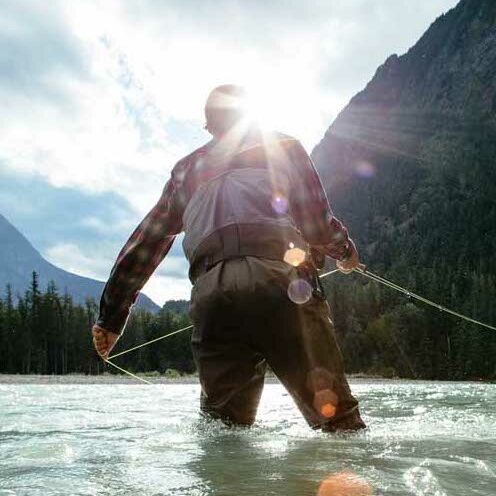Conservation Fund
The BCFFF advocates cooperatively with governments and other organizations throughout British Columbia for the sustainability of fish, their habitats, and quality angling. We participate in government advisory tables, stakeholder forums, and with like-minded organizations, individuals and First Nations on conservation and education projects or policy initiatives. The BCFFF also supports local conservation and education projects and policy initiatives undertaken by its membership through its conservation fund.
Past Projects
Shovelnose Crk.(Squamish R.) berm repair(SSBC) – Osprey &Totem FF
Year: 2016
Grant amount: $5,000
Katzie Sl. Restoration (Watershed Watch Salmon Society)
Year: 2016
Grant amount: $2,600
Spius Creek- Habitat Restoration (Thompson steelhead)
Year: 2012
Grant amount: $10,000
Conservation Fund
The Federation administers a Conservation Fund to support our member anglers, and their clubs in undertaking projects designed to improve fish populations, their habitat, opportunities for enhanced angling or to educate others about the importance of these. The BC Federation of Fly-Fishers established the Conservation Fund over 30 years ago with proceeds from the sale of “The Gilly,” a popular book created and edited by Alf Davey. Originally known as the ‘Gilly Fund,’ it grew substantially when the estate of Charlie Thomas bequeathed a fund to the Federation. Together, they now form the Conservation Fund.
- Projects must occur in British Columbia, and follow all Federal, Provincial or Municipal laws and regulations.
- Because of the fund’s limits, multi-year projects that depend on winning additional funds in subsequent years will not be considered. However, approved projects may require more than one year to complete, and committed funds may be used in a subsequent year if unexpected events cause delays.
- Funds may be conditionally committed to assist a project applicant requesting financing from the Habitat Conservation Trust Fund, Fisheries Renewal BC or similar funding agencies which require complementary grants from other sources as a funding condition. However, in those cases, BCFFF funds would be contingent on those other funds being approved (ie. to assure the viability of the project).
- Relevant project signage and promotional material must give recognition to the Federation.
- The applicant will provide a report back to BCFFF on completion of the project within one year of approval and use of funds. An interim report (written) will be necessary if the project takes more than one year to complete.
- Calculation of project costs must use the same criteria for skilled and unskilled labour, professional consultants, or equipment rentals as Fisheries Renewal BC or other equivalent government agencies. This means that volunteer labour performed by club members is usually costed at approximately $15.00 ($20) per hour. (This does not imply that volunteers will be paid—it is merely a means of computing the value of volunteer input to a project.)
- All applicants must apply using the Conservation Fund Application Form. (insert link here)
- Funding may be paid in stages that relate to the status of the work, and 10% of funds shall be withheld pending completion of the work and submission of a satisfactory final report.
- Project proposals must verify that the local authorities have been informed and the necessary permits are available. Local First Nations must be given a copy of the proposal and asked to comment if they consider it detrimental.
- Applications must be submitted with enough lead time to allow consideration by the committee (at least 2 months). Where the committee may need more information, or possibly an independent evaluation by an expert, more time might be needed.
- Where projects involve fisheries enhancement work, endorsement by a fisheries expert or a provincial fisheries biologist may be required.
- Where several applications are being submitted, a number of criteria will be considered when attributing the highest priority:
- how early (in each calendar year) each application is submitted,
- the $ available in each year,
- the number of BCFFF clubs contributing to the project,
- the total value of the project (total number of contributors),
- the viability window (i.e. outside considerations may affect a priority),
- public visibility,
- how closely the projects supports the purpose of the BCFFF;
- a safety audit and contingency plan provided (if heavy equipment is used, a flag person might be needed to direct traffic, or if boat are used, lifejackets should be supplied, etc.).
- Liabilities:
- The project proponents (and participants) must have adequate liability insurance
- The project must have all necessary approvals: landowners, government, etc.
- Safety audit and contingency plans must be developed before work starts.
- Communications (cell phone, satellite phone, etc.) must be made available at the work site as part of safety.
- Project funds are not normally used to acquire equipment, but can be used for equipment rental, supplies such as gravel and concrete, professional, or technical services and promotional materials.

How it works
A committee representing several regions of the province evaluates proposals according to the fund’s priorities and criteria, and recommends proposals that meet the criteria to the BCFFF Board of Directors for approval. The amount of funds available to any proposed project depends on the project’s relative value, the earnings of the Fund’s principal, and the number of applications received, but is unlikely to exceed $10,000 annually.
Eligible applicants must be a member or a club in good standing and show through their application the ability to carry out the project, and that the project meets the fund’s criteria.
